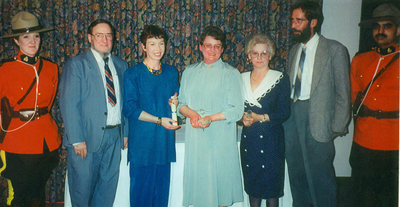
“Hope is Growing” was a suitable motto when the organization first began with a small informal Saskatoon group in the fall of 1979. Since that time it has grown tremendously by the involvement of its members in promoting understanding, education, public awareness, and research. “The Lupus Group” held its inaugural meeting in March 1980 in Saskatoon with Dr. W. Earle DeCoteau as guest speaker and attended by people with lupus from around the province. The lupus community was initially affiliated with The Arthritis Society, but soon struck out on its own. By November the name “Lupus Erythematosus Society of Saskatchewan” (or L.E.S.S.) was chosen, a skeleton constitution was established and the lupin flower logo and motto were developed. Many who were suffering with lupus had never had the opportunity of discussing their symptoms and struggles for control with anyone but their doctors. With the development of Chapters in Saskatoon, Regina and Prince Albert each with their own Chairperson, Lupus Groups in Moose Jaw and Swift Current – each with their own Contact – and Area Contacts established in outlying areas across the province, more and more people came to know about lupus, its symptoms, possible triggers of the disease and available treatment. Although there was no known cure, some hope of remission was supplied through the use of certain drugs and following commonsense rules and applications.
There was very little information available in the early years on this puzzling disease called “the disease with 1,000 faces” and it was difficult to diagnose in its early stages. Books written on the subject were almost non-existent and any informational articles gave little help as to treatments and possible outcome. However, with the advent of the lupus educational support meetings and the newsletter which included articles from rheumatologists and other medical experts, people affected by lupus in Saskatchewan had a life-line.

Awareness was originally created through posters inside buses, on Co-op and Safeway bags, and even on billboards, the latter funded by the Kinsmen. Brochures and leaflets were distributed at several locations, and through time these have been updated and reprinted. In recent years the Fact bulletins which were previously handed out, together with information from well-known rheumatologists and reliable medical sources have been compiled into a popular sized booklet entitled “Living Well With Lupus FACTS” and these have been distributed among Doctors’ offices, Medical Clinics, Area Contacts and other available points.
Our newsletter, “The Saskatchewan Lupine” is still published three times a year but with new technology, color added, better quality paper, excerpts from American and UK newsletters and Canadian Health Journals, copies of Symposium speeches, news and pictures from area lupus-related activities. All this is yours when you take out a Membership of only $20 per year. Personal stories of journeys with lupus are always appreciated. The lupus pin has also been updated and the red lupin on the Saskatchewan-shaped background was a fitting choice.
Even just a few years ago much of the population had never heard of lupus, nor did they understand how a person could feel so totally fatigued when they did not “look sick”, so it was a challenge to attempt any fundraising but that challenge was met with many garage sales, raffles, more sales of crafts and baking, purchase and resale of lupin flowerseed packets, notepaper, souvenir spoons and pins, all bearing the lupin logo. Coin collection tins were set up in area businesses, from the larger and well-known Safeway’s to the smaller corner store, wherever members were willing to apply. Funds raised were used to purchase stationery supplies and postage, typewriter and photocopier, pay for printing of newsletters and brochures, advertising and posters, rentals of meeting rooms and paying for Guest Speakers.
Fortunately there have been those willing and able to step in and take leadership roles over the years, and under their command the Society, now officially known as the Lupus SK Society Inc., has grown and flourished to the point where it is today one of the most successful of all the provincial lupus societies.
